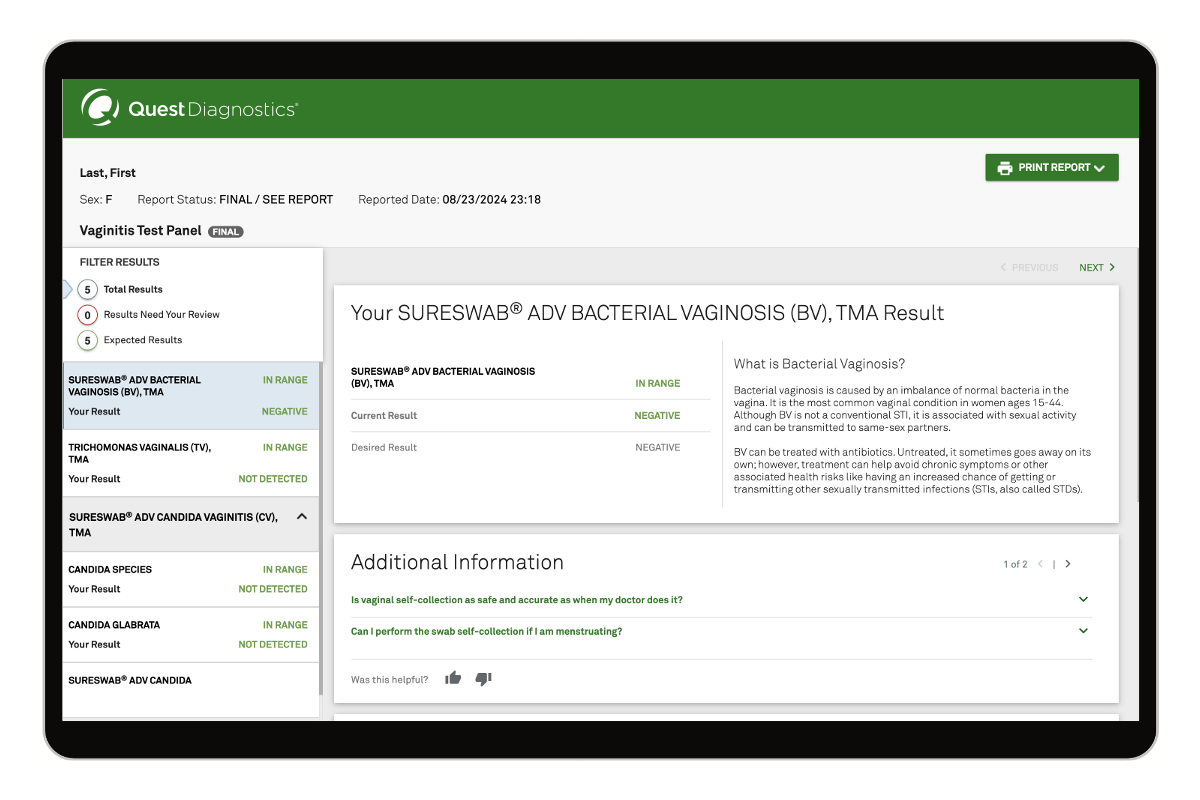Vaginitis Test Panel
This vaginitis panel checks for the most common causes of vaginitis (vaginal inflammation) and abnormal vaginal discharge: bacterial vaginosis, yeast infection, and trichomoniasis. Included with your purchase, if your test results are abnormal, an independent physician may be able to provide you with treatment options. Read moreThis vaginitis test is intended to aid in the diagnosis of vaginitis using patient-collected vaginal swab specimens from individuals with a clinical presentation consistent with vaginitis. Testing for bacterial vaginosis (BV), vulvovaginal candidiasis (yeast infection), and trichomoniasis are included, which are the three most common causes of vaginitis. Understanding the underlying cause is important to help you and your healthcare provider identify the issue and manage symptoms.
With Quest, you can get vaginitis testing by buying this panel online and get testing at a nearby location – no doctor’s visit required.
How it works
questhealth.com offers 100+ consumer-initiated Quest Diagnostics lab tests to empower you to have more control over your health journey. Choose from a variety of test types that best suit your needs.
According to the CDC, by following step-by-step collection instructions, patients can collect their own samples correctly, and the results of the tests are as accurate as when they are collected by a doctor.1
The Quest Patient Service Representative (PSR) will provide you with a vaginal collection kit that comes in a sealed, protective wrapper and includes a step-by-step collection instruction sheet.
Read all instructions before starting to collect a sample. Failure to follow the instructions could affect the test results. If you do not feel comfortable with vaginal self-collection, please contact your doctor. The collection cannot be done by the PSR.
If you have questions prior to performing your self-collection, you may ask the Patient Service Representative (PSR) or call 1-833-700-2423. The concierge line is open Monday-Friday 8:00 AM to 7:00 PM EST. It is closed on weekends and holidays. If you are unable to self-collect, please contact your doctor. The collection cannot be done by the PSR.
References
- CDC. Recommendations for the laboratory-based detection of Chlamydia trachomatis and Neisseria gonorrhoeae. MMWR Recomm Rep. 2014;63(2):1-19. Accessed July 17, 2024. Recommendations for the Laboratory-Based Detection of Chlamydia trachomatis and Neisseria gonorrhoeae — 2014 (cdc.gov)
Sources
- • SureSwab® Advanced Vaginitis, TMA | Test Detail | Quest Diagnostics
- • Vaginitis: Laboratory Testing for Diagnosis and Management | Clinical Focus | Quest Diagnostics
- • Trichomoniasis - STI Treatment Guidelines (cdc.gov)
- • STD Facts - Trichomoniasis (cdc.gov)
- • About Bacterial Vaginosis (BV) | Bacterial Vaginosis (BV) | CDC
- • CDC - Bacterial Vaginosis Statistics
- • Candidiasis Basics | Candidiasis | CDC
- • Untreated Yeast Infection: Why It Should Be Diagnosed and Treated (healthline.com)


